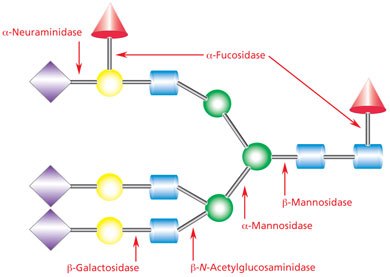Glycan Sequencing Using Exoglycosidases
Determining the sequence and structure of glycans
Enzymatic analysis of oligosaccharides using highly specific exoglycosidases, either sequentially or in a matrix array, is a powerful technique in determining the sequence and structure of glycans. Exoglycosidases remove terminal carbohydrates from the non-reducing end of a glycan, but do not cleave internal bonds between carbohydrates. By using positionally specific exoglycosidases, the removed glycan residues can be identified by linkage as well as sugar. For example, β(1→4) galactosidase will remove terminal β-galactose residues attached with a (1→4) linkage but not residues attached with a (1→3) or (1→6) linkage. In glycan sequencing, the glycan pool is separated into individual oligosaccharides, and each purified glycan is digested sequentially with various linkage-specific exoglycosidase enzymes. An example of an exoglycosidase digestion scheme for the structural analysis of a triantennary complex N-linked glycan is illustrated in Figure 1.

Figure 1. Exoglycosidase enzymes commonly used to determine the structure of N-linked glycans by sequential degradation.
Exoglycosidase digestion, when combined with high-performance separation techniques such as chromatography or electrophoresis, is a rapid and cost-effective method for oligosaccharide characterization. By incorporating enzymatic digestion with capillary gel electrophoresis, the sequence of each glycan in a released pool can be elucidated. When laser-induced fluorescence is the method of detection, picomolar amounts of purified glycoproteins can be sequenced.1
Exoglycosidases have been used in sequencing methods with fluorescent tags attached to the reducing-end of glycans and polyacrylamide gel electrophoresis separations. Integral glycan sequencing (IGS) has been shown to identify complete sequence information in a single experiment. IGS integrates exoglycosidase digestion with a chemical cleavage step and permits rapid sequencing of glycosaminoglycans.2
Picomolar quantities of heparin decasaccharides have been sequenced by matrix-assisted laser desorption/ionization mass spectroscopy (MALDI- MS) after integral glycan sequencing.3 MALDI-MS techniques incorporated with IGS are both sensitive and accurate, detecting as little as 100 femtomoles of oligosaccharides with a reported mass error of ±1 Dalton.3
In addition to sequential degradation of glycans using exonucleases, newer methods have been reported that are capable of structural analysis of glycopeptides without deglycosylation. Temporini, et al., have developed an automated method incorporating on-line digestion of glycoproteins using immobilized pronase and subsequent multistage tandem mass spectrometry (MSn). This technique reduced analysis time from 3 days down to one hour.4 Degucih, et al., have reported using a combination of negative-ion collision-induced dissociation (CID) and positive-ion electron-capture dissociation (ECD) mass spectrometry methods in both positive and negative ion mode. Multistage tandem mass spectrometry (MSn) results were used to assign O-glycan structures attached to peptides, peptide sequences, and location of glycosylation site.5
References
如要继续阅读,请登录或创建帐户。
暂无帐户?